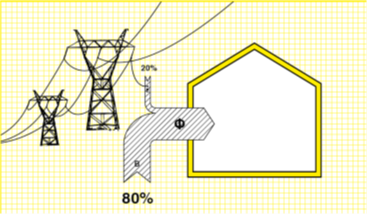Introduction into the difference of Energy, Exergy, and Anergy
Energy comes in different forms. Most know is electricity, classified by professionals as 100% “Exergy”, because it can be transformed entirely into any other form of energy, like thermal heat. When transforming electricity to thermal heat (for example by operating an electric radiator), the resulting energy will always consist of “Anergy” plus “Exergy”. Exergy is that portion of the thermal Energy, which is above the ambient temperature. Thus, Anergy is the other portion of the thermal Energy, which is up to ambient temperature, typically waste heat.
Academic [1]: The maximum fraction of an Energy form which (in a reversible process) can be transformed into work is called Exergy. The remaining part is called Anergy, and this corresponds to the waste heat.
Why is that important?
Heating and cooling make up over 80% of the Energy requirements of (Swiss) Buildings. Thermal Energy is therefore in very high demand, allowing the (re-)use of Anergy, which typically is nothing else than waste or ambient heat. By capturing this waste into a so-called Anergy-Network, heat pumps can operate efficiently as the temperature needs to be “pumped” only from ambient to the space or hot water requirement. The heat pump provides cooled water simultaneous, allowing cooling of other buildings at the same time (see Video “Demand & Supply of Energy“).

Application
By linking various types of buildings and industries, an efficient and effective exchange of thermal Energy can take place, complemented with electricity to run the heat pumps, which in tern could be self-produced by integrating PV panels and/or using natural gas. Realized examples of such systems are at ETH Zurich [2]. On 9 January 2020, ETH Zurich received the Swiss energy prize Watt d’Or 2020 for the anergy grid.
Would that be commercially viable? The response is given at the example of Suurstoffi site in Risch Rotkreuz, which has been evolving since 2010 into an integrated, traffic-free neighborhood with a combination of living, working and recreational facilities. By 2022, it will accommodate some 1,500 residents, nearly 2,000 students and about 2,500 workplaces. Constructed and operated by “Zug Estates AG” with the vision: “In the medium term, we seek to operate our entire portfolio with renewable energy and without CO2 emissions.” The Zug Estates Group has consciously chosen to build up a portfolio of property investments in centrally located sites with a high building density. The consistent implementation of these principles guarantees a resource-efficient investment policy and, not least, promises sustainable, long-term success.
- [1] Honerkamp, J. (2002). Statistical physics. Springer. p. 298. ISBN 978-3-540-43020-9.
- [2] Gabriellia, P. at all (2020). Optimization of low-carbon multi-energy systems with seasonal geothermal energy storage: The Anergy Grid of ETH Zurich, Elsevier Energy Conversion and Management: X. Volume 8, December 2020, 100052 (https://www.sciencedirect.com/science/article/pii/S2590174520300246)